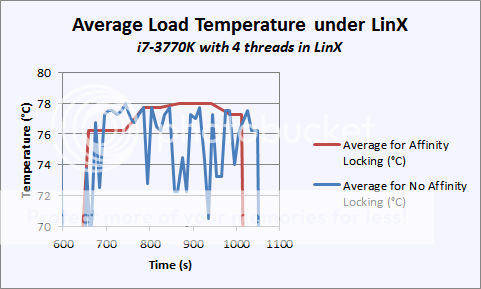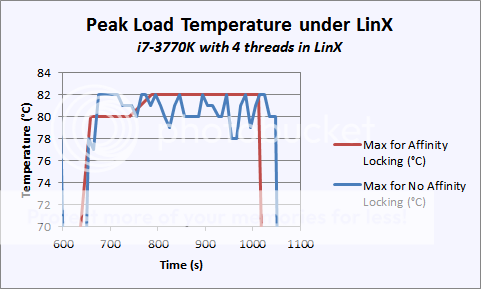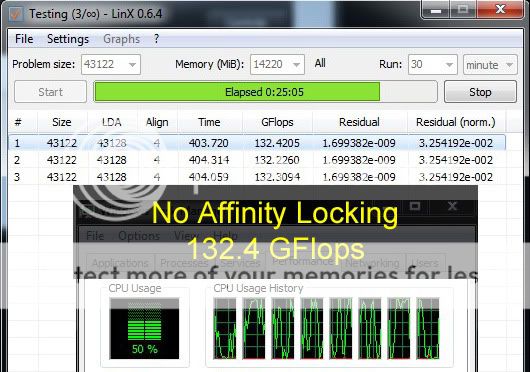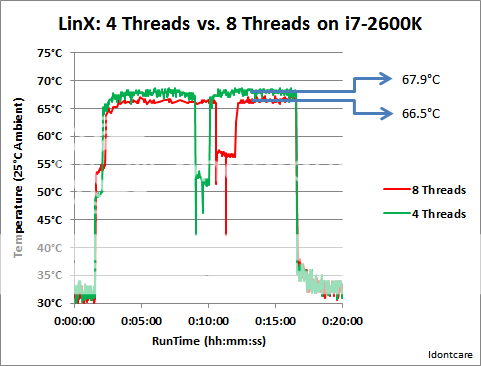- Oct 26, 2012
- 2,059
- 674
- 136
I was always wondering which was the most efficient frequency my i7-3720QM in my Macbook Pro 9,1 ran at. I tested this using Intel Burn Test 2.54 on 8 threads. I ran the test 5 times every 100MHz bump.
Keep in mind this is a 45W CPU and my laptop can only utilize 85W for the entire system.
I ran it 5 times each to get a max temperature since I had a constant 6K fan speed for the entire duration of the test.
My GPU was underclocked to 419MHz memory, and 139MHz core to allow the CPU as much headroom as possible.
This is not a perfect test and I will explain each possible fault. I strongly recommend clicking on the links to have an interactive version.
Interactive Graph: Here

After 3.2GHz, I ran the burn test once just to get a reading. The temperatures are not accurate since Throttling occurs at 105C. The Power Consumption cannot be 100% accurate as well.
I'm also rather peeved at the voltage changes. I can easily see that my CPU has plenty of voltage headroom at lower frequencies; meaning that if I could undervolt the CPU, I would get lower temperatures. Gaming wise, I can easily maintain around ~3.1 Ghz with a nice overclock on the GPU without high temperatures. However, 3.4Ghz is too much for certain games on hot days.
Notice the lack of voltage changes for low frequencies in this Interactive Graph

After gathering the data, I also made a graph depicting GFLOPS per Watt:
Interactive Graph: Here

There is a slight error, the Y axis should be GFlops per Watt, but it should be obvious enough...
Surprisingly, the most efficient frequency for full load is 2.00 GHz. I am wondering how single-threaded workloads would compare. If I did the test single-threaded, I would also be able to stretch out the CPU's frequency to 3.6 GHz without throttling.
I also am wondering what the most efficient frequency is for Desktop i7's and AMD CPU's!
Data Collected:

Edit: Idontcare was kind enough for pointing out that IBT is not optimized for HT. Setting the affinity to 4 cores, I did get a performance boost with lower temperatures. My goal was not to optimize IBT, but to get an idea of efficiency. When I get the time, I will most likely fix the results.
Keep in mind this is a 45W CPU and my laptop can only utilize 85W for the entire system.
I ran it 5 times each to get a max temperature since I had a constant 6K fan speed for the entire duration of the test.
My GPU was underclocked to 419MHz memory, and 139MHz core to allow the CPU as much headroom as possible.
This is not a perfect test and I will explain each possible fault. I strongly recommend clicking on the links to have an interactive version.
Interactive Graph: Here

After 3.2GHz, I ran the burn test once just to get a reading. The temperatures are not accurate since Throttling occurs at 105C. The Power Consumption cannot be 100% accurate as well.
I'm also rather peeved at the voltage changes. I can easily see that my CPU has plenty of voltage headroom at lower frequencies; meaning that if I could undervolt the CPU, I would get lower temperatures. Gaming wise, I can easily maintain around ~3.1 Ghz with a nice overclock on the GPU without high temperatures. However, 3.4Ghz is too much for certain games on hot days.
Notice the lack of voltage changes for low frequencies in this Interactive Graph

After gathering the data, I also made a graph depicting GFLOPS per Watt:
Interactive Graph: Here

There is a slight error, the Y axis should be GFlops per Watt, but it should be obvious enough...
Surprisingly, the most efficient frequency for full load is 2.00 GHz. I am wondering how single-threaded workloads would compare. If I did the test single-threaded, I would also be able to stretch out the CPU's frequency to 3.6 GHz without throttling.
I also am wondering what the most efficient frequency is for Desktop i7's and AMD CPU's!
Data Collected:

Edit: Idontcare was kind enough for pointing out that IBT is not optimized for HT. Setting the affinity to 4 cores, I did get a performance boost with lower temperatures. My goal was not to optimize IBT, but to get an idea of efficiency. When I get the time, I will most likely fix the results.
Last edited:









